Abstract
The widely utilized TiO2 nanoparticles (NPs) tend to accumulate in wastewater and affect microbial growth. This work investigated the impacts of prolonged TiO2 NP addition to filamentous aerobic granular sludge (AGS) using two identical sequencing batch reactors (SBRs, R1 and R2). R1 (the control) had no TiO2 NP addition. In this reactor, filamentous bacteria from large AGS grew rapidly and extended outward, the sludge volume index (SVI30) quickly increased from 41.2 to 236.8 mL/g, mixed liquid suspended solids (MLSS) decreased from 4.72 to 0.9 g/L, and AGS disintegrated on day 40. Meanwhile, the removal rates of COD and NH4+-N both exhibited significant declines. In contrast, 5–30 mg/L TiO2 NPs was added to R2 from day 21 to 100, and the extended filamentous bacteria were effectively controlled on day 90 under a 30 mg/L NP dosage, leading to significant reductions in COD and NH4+-N capabilities, particularly the latter. Therefore, NP addition was stopped on day 101, and AGS became dominant in R2, with an SVI30 and MLSS of 48.5 mL/g and 5.67 g/L on day 130. COD and NH4+-N capabilities both increased to 100%. Microbial analysis suggested that the dominant filamentous bacteria—Proteobacteria, Bacteroidetes, and Acidobacteria—were effectively controlled by adding 30 mg/L TiO2 NPs. XRF analysis indicated that 11.7% TiO2 NP accumulation made the filamentous bacteria a framework for AGS recovery and operation without NPs. Functional analysis revealed that TiO2 NPs had stronger inhibitory effects on nitrogen metabolism compared to carbon metabolism, and both metabolic pathways recovered when NP addition was discontinued in a timely manner. These findings offer critical operational guidance for maintaining the stable performance of filamentous AGS systems treating TiO2 NP wastewater in the future.
1. Introduction
Over the past decade, TiO2 nanoparticles (NPs), as successful engineered nanomaterials, have been extensively applied in industrial production processes such as paper manufacturing, electronics, and photocatalytic materials [1]. Consequently, NPs at concentrations ranging from ng/L to mg/L have been frequently detected in aquatic environments [2,3]. NPs exhibit significant toxicity to microbial communities, including bacteria, algae, and protozoa, through multiple mechanisms, including cellular membrane damage, genetic material alteration, and disruption of energy metabolism [4,5,6]. The inevitable accumulation of NPs in wastewater systems poses dual threats: while short-term exposure may enhance sludge settling performance via improving flocculation [7], chronic exposure critically impairs essential nutrient removal functions, particularly nitrogen and phosphorus metabolisms [8]. This paradoxical effect creates substantial operational challenges for conventional activated sludge (CAS) when treating NP wastewater.
Aerobic granular sludge (AGS) has been widely implemented in wastewater treatment systems, from lab- to full-scale bioreactors, over the past decades, owing to its excellent settleability, abundant biomass, and high resistance loading [9,10,11]. However, maintaining long-term operational stability remains a significant challenge, with filamentous bacterial overgrowth emerging as a critical limiting factor. Previous studies have identified multiple parameters influencing filamentous bacterial proliferation, including sludge size, dissolved oxygen (DO), pH, and nutrient type [12,13,14]. Subsequently, various mitigation strategies have been developed to control filamentous bacterial growth. These approaches include controlling sludge size with a spiny aeration device or removing oversized granules [15]; improving organic loading rate, shear force, or salinity [16]; adding chemicals (NaClO, Cl2, or H2O2), ballasting agents and coagulants, particulate substrates, and sludge micropowder [17,18,19]. Although these strategies have demonstrated efficacy, current research predominantly addresses filamentous proliferation in CAS systems rather than AGS. Recent studies have systematically investigated the effects of NP addition on normal AGS systems, focusing on granulation dynamics, operational stability, organic removal efficiency, ecotoxicological impacts, and microbial evolution. Results demonstrated that ZnO and CuO NPs had negative effects on nitrogen transformations [20,21] and phosphorus removal [22,23]. Adding TiO2 NPs could improve sludge settleability and decrease nitrogen removal, and SiO2 would decrease sludge settleability and have no effect on nitrogen removal [3]. Meanwhile, the co-existence of CuO and ZnO NPs at a low dosage of 1 mg/L had no significant effect on nitrogen removal performance, suggesting that single NPs possess higher toxicity than the mixtures [24]. Nano iron, nano zero valent iron (nZVI), and magnetic nano iron have also been employed to evaluate normal AGS response. Adding iron NPs enhances sludge granulation through microbial metabolic activity, extracellular polymeric substance (EPS) secretion, electron transfer characteristics, and bacterial community shifts [25,26,27], mitigating membrane fouling in the AGS-membrane system via iron oxide adsorption [28]. Remarkably, AGS has exhibited exceptional resilience to toxic metalloids (SeIV/TeIV), achieving simultaneous nutrient removal and biosynthesis of Se0/Te0 nanostructures [29,30] or AuNPs [31]. However, co-exposure to NPs and antibiotics caused synergistic inhibition of nutrient removal through combined damage to cell membranes, EPS matrices, and microbial consortia, ultimately altering nitrogen transformation pathways [24,32]. Despite these advances, the investigation of filamentous AGS exposed to 5–30 mg/L TiO2 NP wastewater remains poorly understood.
The primary objective of this experiment was to investigate the effects of adding 5–30 mg/L TiO2 NPs to extended filamentous AGS in SBRs using artificial wastewater. Filamentous bacterial inhibition, sludge characteristics, organic degradation, microbial community, and metabolic pathways were also examined in this study. NP enrichment in sludge was also detected using X-ray fluorescence (XRF) spectroscopy. It is hoped that this study will provide a reference for controlling filamentous bacteria in an AGS system using NP wastewater in the future.
2. Materials and Methods
2.1. Preparation of TiO2 NPs
White TiO2 NPs with a mean size of 40–50 nm (Figure 1A) were commercially procured from Xianfeng Nanomaterials Technology Co., Ltd. (Nanjing, China). The TiO2 NP solution was prepared using the following method: Precise quantities of TiO2 NPs (0.15, 0.3, 0.6, and 0.9 g) were individually weighed and dispersed into 300 mL of Milli-Q water, followed by 30 min of ultrasonication (25 °C, 100 W, 40 kHz) to obtain homogeneous suspensions each time (Figure 1B). The NP solution was immediately transferred to the plastic tank and diluted to 30 L with artificial wastewater. Finally, the concentrations of TiO2 NPs in the experiment were 5, 10, 20, and 30 mg/L each time, respectively.
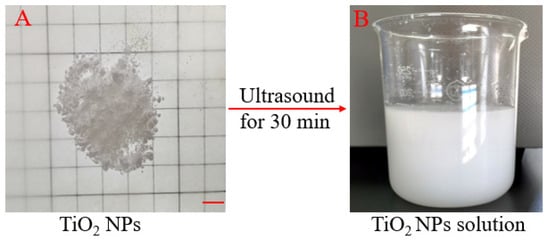
Figure 1.
TiO2 NPs (A) and their solution after 30 min of ultrasonification (B). Scale bar: 0.5 cm.
2.2. Operation of the SBRs
Two identical SBRs (R1 & R2) made of plexiglas with effective volumes of 3.6 L (H × D = 60 cm × 10 cm) were used in this work (Figure 2). R1 (the control) had no TiO2 NP addition, whereas TiO2 NPs were added to R2 at concentrations of 0–30 mg/L throughout the experiment. Two fine air pumps (PL60, RESUN, Chaozhou, China) were used to supply aeration to the bottom of the SBRs through air diffusers with a uniform airflow rate of 0.5 m3/h and a 50% volumetric exchange ratio. Each 240-min cycle consisted of the following steps: feeding for 5 min, aeration for 180 min, settling for 2 min, discharge for 5 min, and idle time for 48 min. All pumps and valves were controlled by programmable logic controllers (PLCs) in this experiment. The indoor temperature was maintained at 20 ± 5 °C using industrial-grade air conditioning (Haier, Qingdao, China), and the pH of wastewater was maintained at 7.0–7.5 using an appropriate amount of 10% HCl.
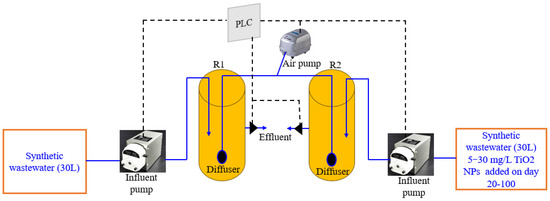
Figure 2.
Schematic diagram of the two bioreactors used in the experiment.
2.3. Wastewater and Seeding Sludge
R1 and R2 were fed with acetate-containing synthetic wastewater. Artificial wastewater is mainly composed of sodium acetate (NaAc), NH4+-N, and KH2PO4, serving as carbon, nitrogen, and phosphorus sources, respectively. The detailed composition of the synthetic wastewater was as follows: NaAc 600 mg/L, NH4Cl 100 mg/L, KH2PO4 60 mg/L, FeSO4·7H2O 8 mg/L, CaCl2 21 mg/L, MgSO4·7H2O 102 mg/L, and trace element solution 0.5 mL/L. Subsequently, influent COD, NH4+-N, and total phosphorus (TP) were maintained at 400–500 mg/L, 20–25 mg/L, and 10–15 mg/L, respectively. The wastewater was manually prepared once every three days and then stored in a sealed plastic tank with a pump for stirring. The composition of the trace elements can be found in an early work [33]. The seeding sludge was AGS with an average particle size of 3 mm, obtained from our lab-scale SBR (Figure 3A,E).
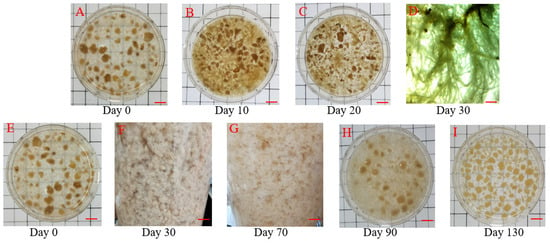
Figure 3.
(A–I) Images of AGS in R1 and R2; scale bar: 0.5 cm.
2.4. Analytical Methods
2.4.1. Analysis of Water Quality and Sludge Properties
COD, NH4+-N, ML(V)SS, and SVI (SVI5 and SVI30) values were measured using standard methods [34]. Sludge morphological changes were observed using an optical microscope (NE600, GREEN, Nanjing, China) and smartphone (Magic 6pro, Honor, Shenzhen, China). EPS were extracted using the formaldehyde–NaOH method [35]. Polysaccharide (PS) concentration was determined using the phenol–sulfuric acid method with glucose as the standard [36]. The protein (PN) concentration was determined using Coomassie brilliant blue with bovine serum albumin (BSA) as the standard [37]. Sludge samples S0, S2, S3, S4, and S6 were first oven-dried at 105 °C for 2 h, then manually ground into sludge powders and put into 10 mL centrifuge tubes. These powders were used to detect elemental composition using XRF.
2.4.2. Analysis of Microbial Community
Seven sludge samples (S0–S6) from R2 were regularly collected on day 0, 20, 40, 60, 80, 100, 110, and 130. Each sample was randomly collected three times and then mixed into one tube (10 mL). All tubes were promptly stored in a refrigerator at −20 °C for microbial analysis. All sludge samples were sent to Major Bio-pharm Technology Co., Ltd. (Shanghai, China) for microbial analysis. DNA extraction was performed using the E.Z.N.ATM Mag-Bind Soil DNA Kit (OMEGA, Norcross, GE, USA) according to the manufacturer’s instructions. Microbial analysis was conducted at this company using the Illumina Nextseq2000 platform (Illumina, San Diego, CA, USA). About 10 ng DNA of the sludge sample was used for 16S rDNA sequencing targeting the hypervariable V3–V4 regions. The data were processed using the Quantitative Insights into Microbial Ecology (Qiime) (v 1.91) pipeline (http://qiime.org/ (accessed on 26 October 2024)) and Mothur (v1.30.2). Bacterial analysis was carried out based on high-quality sequences with a similarity threshold of 97%. Bioinformatic analysis of the sludge was carried out using the Major-bio cloud platform (https://cloud.majorbio.com (accessed on 26 October 2024)). Operational taxonomic units (OTUs) and coverage were calculated using Mothur (v1.30.2). Microbial dynamic analysis was also conducted on the phylum and genus levels. The similarity among the microbial communities in different samples was determined using principal coordinate analysis (PCoA) and non-metric multi-dimensional scaling (NMDS) based on the OTUs using an unweighted unifrac distance. Furthermore, microbial metabolic pathways in the S0–S6 samples were predicted using PICRUSt2 (v2.2) with reference to the Kyoto Encyclopedia of Genes and Genomes (KEGG) database.
3. Results and Discussion
3.1. Variations in Sludge Characteristics
Figure 3 shows the morphological evolution of sludge in R1 and R2. Both SBRs were initially inoculated with lab-cultured AGS with a mean diameter of 3 mm, showing filamentous structures (Figure 3A,E). Filamentous bacteria grew quickly in R1 due to the easily biodegradable carbon resource NaAC, coinciding with an increase in AGS size (Figure 3B). Subsequently, excessive filamentous growth proliferated and extended outward from large AGS on day 20 (Figure 3C), and in the absence of effective action, the filamentous bacteria became dominant, leading to AGS disintegration on day 30 (Figure 3D). These results confirm that NaAC promotes filamentous bacterial growth [16,19]. Conversely, R2 was fed with synthetic wastewater containing 5–30 mg/L TiO2 NPs from day 21 to 100. While TiO2 NP concentrations of 5–20 mg/L showed limited effect on filamentous bacterial growth (Figure 3F,G), increasing the dosage to 30 mg/L on day 80 resulted in filamentous bacterial suppression and gradual AGS recovery on day 90 (Figure 3H). After NP supplementation was terminated on day 101, the extended filamentous bacteria were eliminated, and well-structured AGS re-emerged on day 130 (Figure 3I). This demonstrated that 30 mg/L TiO2 NPs effectively inhibited extended filamentous bacterial overgrowth, maintaining AGS stability. These experimental results clearly established that filamentous bacteria are sensitive to high dosages of TiO2 NPs [3,28].
Correspondingly, MLSS and SVI were systematically monitored in both SBRs (Figure 4). In R1, the uncontrolled proliferation of extended filamentous bacteria (Figure 3A–D) was correlated with dramatic changes in MLSS and SVI30. MLSS declined from 4.72 to 0.61 g/L and SVI30 increased from 41.2 to 236.8 mL/g between day 0 and 40 (Figure 4A). Ultimately, a large amount of sludge was washed out from R1, leading to AGS collapse and indicating that R1 failed. This was well in agreement with previous studies [14,23]. In order to maintain operational stability, R2 was fed with artificial wastewater containing 5–30 mg/L TiO2 NPs from day 20 to 100 (Figure 4B). The initial 5 mg/L NP supplementation failed to prevent SVI30 elevation or MLSS reduction from day 0 to 40; specifically, SVI30 increased from 41.5 mL/g to 114 mL/g, and MLSS slowly decreased from 4.75 g/L to 4.46 g/L in stages a and b (Figure 4B). With increasing NP dosage, SVI30 presented a downward trend and MLSS showed an upward trend in stages c and d (Figure 4B). When the NP concentration reached 30 mg/L, the excessive proliferation of the extended filamentous bacteria was restrained, and AGS gradually recovered on day 90 (Figure 3H). After TiO2 NP addition was stopped, AGS with a compact structure and regular boundaries appeared again on day 130 (Figure 3I). In the end, both MLSS and SVI30 in R2 stabilized at 5.67 g/L and 48.5 mL/g (Figure 4B). Interestingly, the curve of the MLVSS/MLSS ratio showed a descending trend from day 0 to 100 and then an ascending trend from day 101 to 130 (Figure 4B). These findings demonstrated that low concentrations of NPs (<30 mg/L) were ineffective in suppressing filamentous bacteria, whereas higher concentrations (≥30 mg/L) successfully inhibited filamentous bacterial overgrowth. However, the increased NP dosage negatively impacted the MLVSS/MLSS ratio, likely due to the sedimentation of a portion of NPs in the sludge [3,26].
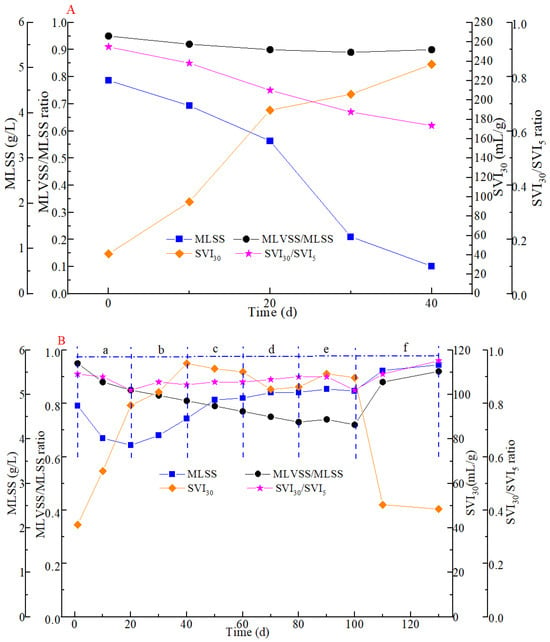
Figure 4.
Changes in MLSS and SVI in R1 (A) and R2 (B). Stages a–f represent TiO2 NP dosage of 0, 5, 10, 20, 30, and 0 mg/L in R2, respectively.
The EPS secreted by bacteria plays an important role in maintaining the AGS structure for stable reactor performance. The concentrations of EPS, PN, and PS were quantified throughout the experiment (Figure 5A,B). Generally, EPS, PN, and PS in R1 still decreased from 64.9, 30.1, and 34.8 mg/(g·VSS) to 40, 12.3, and 37.7 mg/(g·VSS) on day 40, respectively, and the PN/PS ratio decreased from 0.86 to 0.67 (Figure 5A), coinciding with filamentous bacterial overgrowth (Figure 3B–D), a quick increase in SVI30, and a rapid decrease in MLSS (Figure 4A). Finally, this imbalance accelerated sludge disintegration [19,37]. In contrast, when 5–30 mg/L TiO2 NPs were added to R2, EPS, PN, and PS all increased from 64.8, 30.2, and 34.6 to 106.3, 32.8, and 73.5 mg/(g·VSS) on day 90, respectively (Figure 5B). This was due to microbes producing more EPS to protect themselves from the toxic effects of TiO2 NPs [38]. After the extended filamentous bacteria were restrained (Figure 3H), NP addition was stopped on day 101. EPS gradually decreased and then stabilized at 92.4 mg/(g·VSS) on day 130. Meanwhile, the PN/PS ratio reached 0.98 (Figure 5B). PN provided a steric structure, and PS as a biogel facilitated AGS structural reintegration [3,38]. Subsequently, AGS with an integrated structure recovered well on day 130 (Figure 3I). The study revealed that NP dosage stimulated microbial EPS secretion as a protective response against TiO2 NP toxicity [38,39].
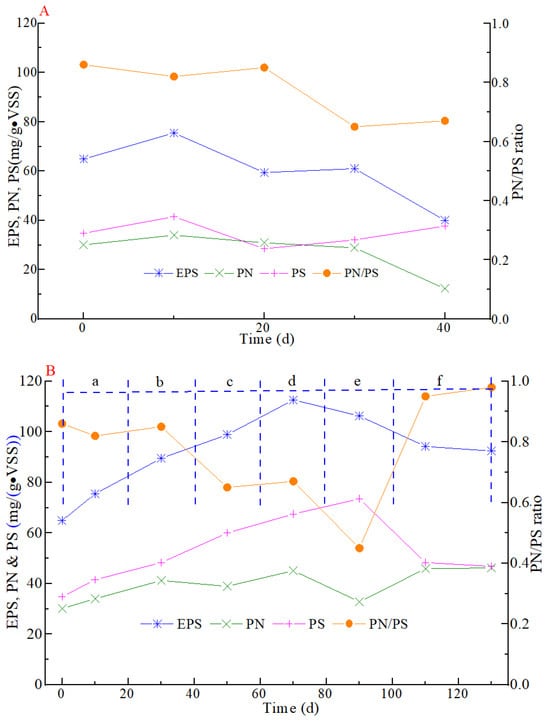
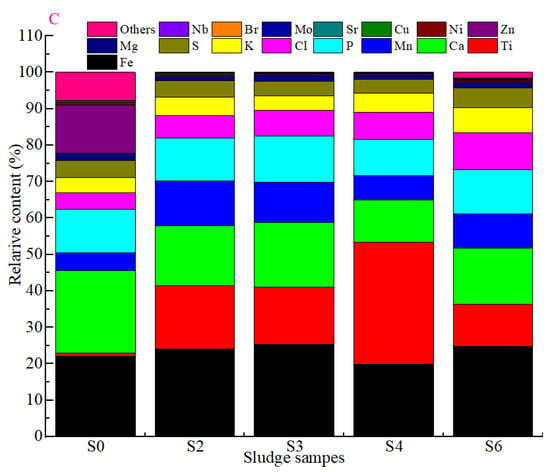
Figure 5.
Changes in EPS in R1 (A) and R2 (B); sludge elemental analysis using XRF (C).
The elements of the sludge samples (S0, S2–S4, S6) from R2 were analyzed using XRF. As shown in Figure 5C, the seeding sludge (S0) contained the main elements of Fe (22.13%), Ca (22.7%), Zn (13.12%), Mn (4.83%), S (4.70%), Cl (4.61%), and Mg (1.95%). Notably, the proportion of Ti quickly increased from 0.83% (S0) to a peak of 33.39% (S4) following the addition of 5–30 mg/L TiO2 NPs between day 21 and 100 (Figure 3). This value finally decreased to 11.7% (S6) with the cessation of NP dosing between day 101 and 130 (Figure 5C). This confirmed that TiO2 NPs sedimented in the sludge [3], resulting in a lower MLVSS/MLSS ratio in stages b–e (Figure 4B). Concurrently, Fe, Ca, and Zn content declined from 22.13%, 22.7%, and 13.12% (S0) to 19.92%, 11.69%, and 0.27% (S4), and then rose to 24.74%, 15.31%, and 0.39% (S6), respectively. These elements contributed to aggregation and EPS production, facilitating AGS structural recovery [19]. This indicated that NPs reduced Fe, Ca, and Zn metal deposition in AGS. In summary, these findings demonstrated that TiO2 NPs induced significant Ti sedimentation while suppressing Fe, Ca, and Zn accumulation. High NP dosage altered metal sedimentation in the AGS system [3,30,40], highlighting the need for NP dosage optimization in practice.
3.2. Performance of Organic Degradation in Both SBRs
The performance of COD and NH4+-N degradation processes in both SBRs was systematically monitored throughout the experiment (Figure 6). Generally, the influent COD and NH4+-N in the two SBRs remained stable within the range of 420–490 mg/L and 21–25 mg/L, respectively. Effluent COD and NH4+-N showed similar changes from day 0 to day 20, but significant differences from day 21 to day 130 (Figure 6). Specifically, the effluent COD and NH4+-N in R1 increased rapidly from 0 mg/L to 180 and 11.9 mg/L on day 40 (Figure 6A). Correspondingly, the removal rates of COD and NH4+-N also quickly decreased from 100% to 58.5% and from 100% to 43.6% because the uncontrolled filamentous bacteria grew excessively in R1 (Figure 3A–D), resulting in impaired sludge settling performance. Subsequently, a large amount of biomass with high SVI30 was washed out, and MLSS greatly reduced in R1 (Figure 4A). These findings indicate that extended filamentous bacteria have negative impacts on sludge properties and organic degradation [16,17,19].
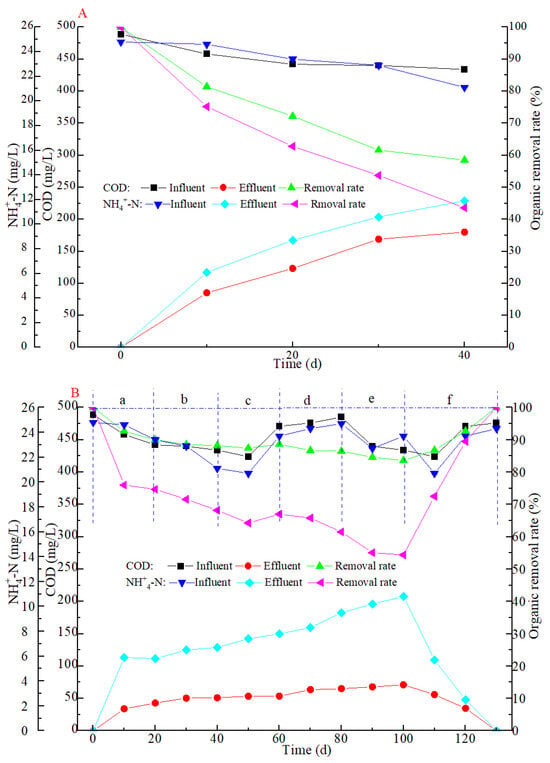
Figure 6.
Organic removal efficiencies in R1 (A) and R2 (B).
Compared to R1, R2 demonstrated superior organic degradation performance (Figure 6B). Both effluent COD and NH4+-N in R2 showed an increasing tendency under the dual actions of filamentous bacterial over-proliferation and the addition of 5–30 mg/L NPs, reaching peak values of 71.2 and 10.8 mg/L on day 100. With the termination of NP addition on day 101, both values decreased to 0 mg/L (Figure 6B), and AGS recovered well on day 130 (Figure 3I). Correspondingly, COD and NH4+-N removal rates in R2 decreased from 100% on day 0 to 83.6% and 54.4% on day 100, and then increased again to 100% on day 130 (Figure 6B). High concentrations of NPs (≥30 mg/L) restrained extended filamentous bacterial overgrowth, thereby preventing sludge deterioration (Figure 3E–I). However, the accumulated TiO2 NPs (Figure 5C) exhibited toxic effects on the microbial community, especially on nitrifying or denitrifying bacteria [3,22]. This experiment revealed that long-term exposure to TiO2 NPs had a more suppressive effect on ammonia nitrogen degradation than on carbon reduction [22,24,41].
3.3. Microbial Composition and Functional Groups
Seven sludge samples (S0–S6) from R2 were analyzed using 16S rRNA to characterize the microbial community on the phylum and genus levels in this experiment. A total of 54,088–58,518 high-quality reads with a mean length of 411–421.6 bp were obtained, which were clustered into 213–290 OTUs with 0.99 coverage. As shown in Figure 7A, seven phyla were consistently detected in all sludge samples. The predominant phyla in the seeding sludge (S0) were Firmicutes, Proteobacteria, Bacteroidetes, and Actinobacteria, with relatively high abundances of 0.56, 0.21, 0.07, and 0.06, respectively. These microbes are commonly found in AGS and CAS and are known for their roles in EPS production and organic degradation [19,22,33]. The percentage of Proteobacteria initially rose to 0.37 (S1) in the absence of TiO2 NPs from day 0 to 20, then fell to 0.21 (S4) with the addition of 5–30 mg/L NPs from day 21 to 100 (Figure 7A). Following NP withdrawal from day 101 to 130, its proportion increased and stabilized at 0.51 (S6), as extended filamentous bacterial overgrowth was inhibited and AGS recovered completely on day 130 (Figure 3I). This was consistent with previous reports [3,19,21]. Similar trends were observed for Actinobacteria, Bacteroidetes, and Verrucomicrobia. Proteobacteria, Acidobacteria, and Bacteroidetes are recognized as typical filamentous bacteria and commonly associated with sludge bulking [16,19]. They were initially controlled by the timely addition of TiO2 NPs and subsequently served as structural frameworks for AGS regranulation (Figure 3H,I) [3,20]. In contrast, Firmicutes abundance rapidly decreased to 0.16 in the absence of NPs from day 0 to 21(S1), rebounded to 0.48 (S4) with increasing NP dosage (5–30 mg/L) from day 21 to 100, and then sharply declined, stabilizing at 0.01 (S6) as AGS recovered on day 130 (Figure 7A). These results demonstrate that the predominant filamentous bacteria Proteobacteria, Acidobacteria, and Bacteroidetes were sensitive to TiO2 NP addition [3,22].
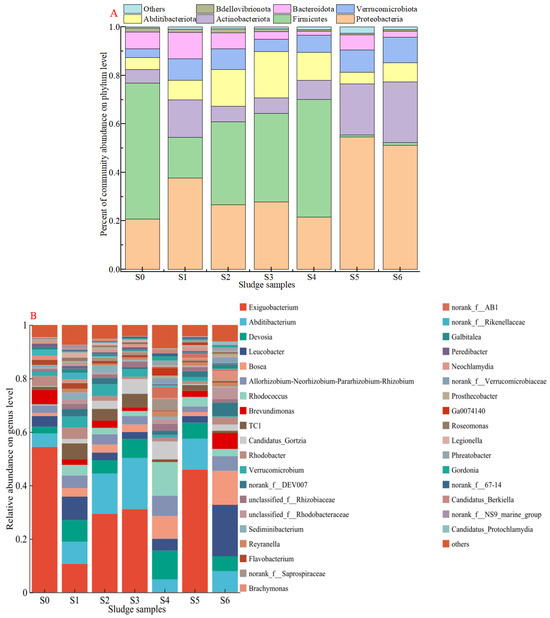
Figure 7.
Microbial community in all sludge samples (S0–S6) at the phylum (A) and genus levels (B).
The top 37 genera were found in all sludge samples in this work (Figure 7B). Exiguobacterium, which belongs to Firmicutes, became the dominant genus in the seeding sludge with a relative abundance of 0.54 (S0), then decreased following the addition of 5–30 mg/L TiO2 NPs from day 21 to 100 (Figure 7B). The lowest abundance was 0.0009 (S4) when the NPs dosage reached 30 mg/L on day 100. When NP addition stopped, its abundance increased to 0.46 (S5) and remained at a low level (S6) after large AGS had recovered with a compact structure. This indicated that NP dosage and sludge structure played a crucial role in Exiguobacterium proliferation [22]. Abditibacterium abundance showed a progressive increase during NP addition (S0–S4) from day 21 to 100, and decreased to 0.08 (S6) after AGS recovered on day 130. Conversely, Leucobacter (a genus of Actinobacteriota) exhibited a gradual decline upon exposure to 5–30 mg/L TiO2 NPs (S0–S4), then increased and stabilized at 0.19 (S6) after NP addition was suspended on day 101. This was consistent with the literature reports of its prevalence in industrial wastewater [22,24,42]. Flavobacterium had a relatively low abundance of 0.02 in the seeding sludge (S0), and this value decreased progressively upon exposure to 5–30 mg/L NPs (S1–S4). Finally, it remained at 0.006 (S6) when NP addition stopped and AGS recovered on day 130. Flavobacterium, as a typical filamentous bacterium, is often detected in sludge bulking and is extremely sensitive to TiO2 NPs [19,20].
Beta diversity analysis was also carried out using both PCoA and NMDS based on unweighted unifrac distance (Figure 8A,B). As shown in Figure 8A, the PCoA results revealed significant microbial community differences, with principal components PC1 and PC2 explaining 45.73% and 18.39% of the total variance, respectively. Notably, the inoculated sludge (S0) displayed a remarkable gap compared with the other samples (S1–S6). While sludge was exposed to 5–20 mg/L TiO2 NPs, the S1–S3 samples clustered relatively close together. When the NP dosage increased to 30 mg/L, S4 exhibited marked divergence. Interestingly, even after NP addition ceased on day 101, the S5 and S6 samples still remained significantly distinct (Figure 8A). Correspondingly, the NMDS analysis (Figure 8B) yielded patterns consistent with the PCoA results (Figure 8A). The seeding sludge S0 exhibited significant separation from the subsequent samples, reflecting distinct microbial community structures shaped by extended filamentous bacterial proliferation (S2) and TiO2 NP addition (S3, S4). Even after NP cessation on day 101, the S4 and S5 samples demonstrated persistent divergence. This suggested that TiO2 NP exposure induced irreversible alterations in bacterial community structure [42]. Consequently, the S0–S6 samples were divided into five distinct clusters I (S0), II (S1–S3), III (S4), IV (S5), and V (S6)—according to the PCoA and NMDS results (Figure 8).
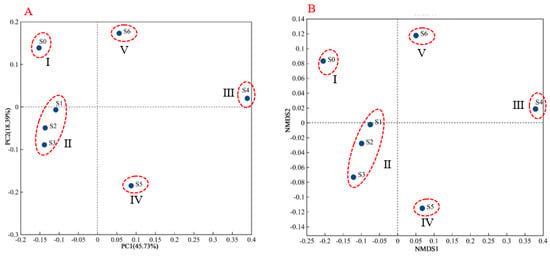
Figure 8.
Plots generated by PCoA (A) and NMDS (B) based on OTUs using unweighted unifrac distance.
Figure 9 presents the heatmap analysis of functional metabolisms related to carbon and nitrogen degradation pathways. The ranges of hydrocarbon degradation functional groups involving aliphatic non-methane, aromatic, and other hydrocarbons increased from 173–343 (S0) to a peak value of 5716–5721 (S4) as TiO2 NP concentration rose from 0 to 30 mg/L during days 21–100. However, the values decreased and stabilized at 1233–1234 (S6) after NP cessation. Notably, other hydrocarbon degradation functional groups related to aerobic chemoheterotrophy and general chemoheterotrophy showed consistent increases throughout the experiment (S0–S6). In contrast, nitrite reduction functional groups (nitrate/nitrite/nitrous oxide denitrification, nitrate/nitrite/nitrous respiration, and nitrate) initially declined from 724–766 (S0) to 74–124 (S3), and then rose to the range of 1696–1988 (S6). These findings revealed that TiO2 NPs exerted more pronounced inhibitory effects on NH4+-N removal than on COD removal [3,24,41]. These metabolic patterns were corroborated by the COD and NH4+-N degradation profiles shown in Figure 6B.
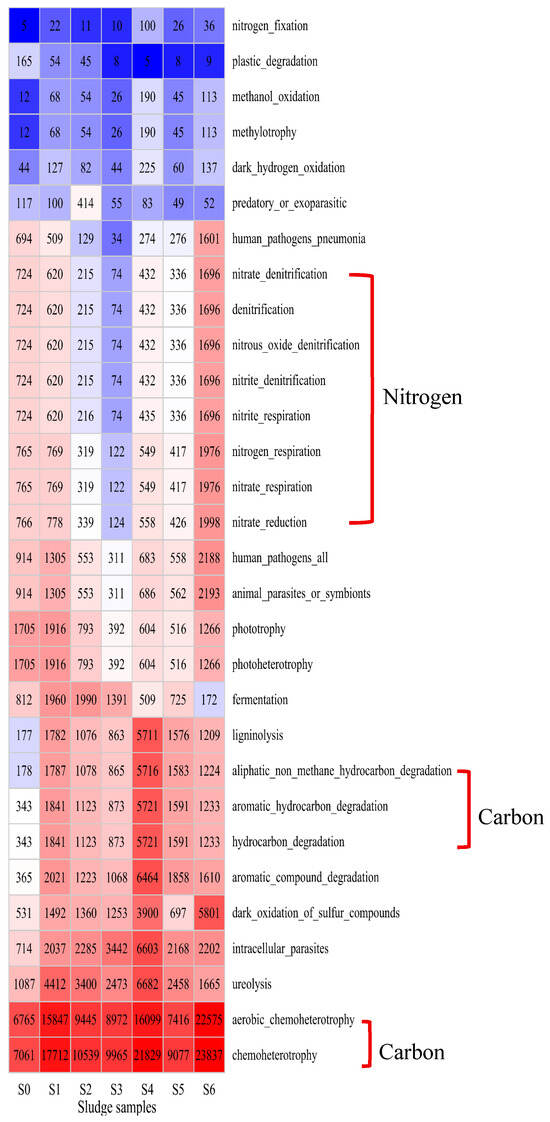
Figure 9.
Functional heatmap associated with nitrogen and carbon metabolism under TiO2 NP concentrations of 0–30 mg/L.
3.4. Proposed Model of TiO2 NPs for Extended Filamentous AGS
This study proposed a model for controlling extended filamentous bacterial overgrowth to prevent AGS disintegration by adding TiO2 NPs (Figure 10). The filamentous bacteria rapidly grew in large AGS fed with artificial wastewater containing easily degradable substances (NaAC) (Figure 3A–C), coinciding with deteriorating sludge characteristics (MLSS, SVI, EPS) in the absence of TiO2 NPs (Figure 4A and Figure 5A). Finally, AGS disintegrated (Figure 3D), leading to poor organic degradation (Figure 6A) [12,13,16,19]. The dominant filamentous bacterial phyla—Proteobacteria, Acidobacteria, and Bacteroidetes—all increased as 5–30 mg/L TiO2 NPs were added in a timely manner to the bioreactor between days 21 and 100. TiO2 NP sedimentation reached 11.7% (Figure 5C), making these phyla a framework for granular sludge recovery [3,26,27,40], even though NP addition terminated on day 101. Meanwhile, Ca, Fe, Mg, and Mn accumulation (Figure 5C) enhanced sludge reaggregation in this study [33,38,39]. Importantly, TiO2 NPs demonstrated stronger inhibition on nitrogen transport pathway than on carbon metabolism (Figure 9), resulting in worse NH4+-N removal performance compared to COD removal (Figure 7B) [22,23,24,25]. After the cessation of NP addition, AGS recovered with a regular shape (Figure 3I), better sludge properties relating to MLSS, SVI, EPS (Figure 4B and Figure 5B), and enhanced organic removal performance on day 130 (Figure 6B). This was because nitrogen and carbon metabolisms enhanced after NP addition was stopped between days 101 and 130 (Figure 9). However, microbial community analysis confirmed irreversible structural alterations in the presence of TiO2 NPs in the experiment (Figure 7 and Figure 8).
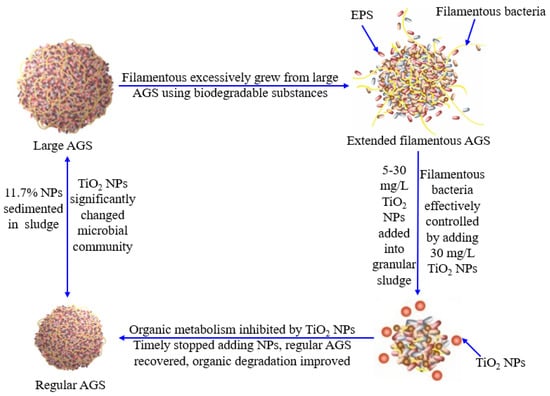
Figure 10.
Proposed model of extended filamentous bacteria controlled by adding TiO2 NPs to the AGS system.
4. Conclusions
On day 30, the filamentous bacteria proliferated excessively and extended outward from large AGS fed with artificial wastewater. But they were effectively inhibited by adding 30 mg/L TiO2 NPs. Correspondingly, the abundances of predominant filamentous bacteria—Proteobacteria, Acidobacteria and Bacteroidetes—decreased, and AGS with a regular shape gradually recovered on day 130. Notably, 11.7% TiO2 NP sedimentation enabled the filamentous bacteria to serve as a framework for granular sludge reformation. The accumulated metal ions Ca, Mg, Fe, and Mn enhanced sludge regranulation after NP addition stopped on day 101. COD and NH4+-N removal rates both showed decreasing trends upon exposure to 5–30 mg/L TiO2 NPs; in particular, the latter showed a significant change under 30 mg/L NPs. This is because high concentrations of TiO2 NPs exerted stronger suppression on nitrogen metabolism than on carbon metabolism. Cessation of NP addition restored metabolic functions, improving organic degradation. Briefly, TiO2 NPs positively controlled filamentous bacterial overgrowth and negatively impacted organic degradation. Therefore, one needs to comprehensively consider filamentous bacterial inhibition and treatment efficiency when applying the filamentous granular sludge process to TiO2 NP-containing wastewater in the future.
Author Contributions
Data curation, validation, and writing—original draft, J.L., S.L., S.Y. and Z.C.; writing—review and editing, X.M.; funding acquisition, resources, supervision, and writing—review and editing, J.L. and B.X. All authors have read and agreed to the published version of the manuscript.
Funding
This research was funded by the financial support from the Open Project of Northwest China Key Laboratory of Water Resources and Environment Ecology (2022SZY05), Science and Technology Planning Project of Jiaxing (2025CGZ078), and State Key Laboratory of Urban Water Resources and Environment (HC202156).
Data Availability Statement
The data presented in this study are available on request from the corresponding author.
Conflicts of Interest
The authors declare no conflicts of interest. This study does not include experiments conducted on humans or animals.
References
- Thakura, N.; Kumar, A.; Thakurc, V.K.; Kaliad, S.; Aryae, V.; Kumare, A.; Kumarf, S.; Kyzas, G.Z. A critical review on the recent trends of photocatalytic, antibacterial, antioxidant and nanohybrid applications of anatase and rutile TiO2 nanoparticles. Sci. Total Environ. 2024, 914, 169815. [Google Scholar]
- Navidpour, A.H.; Xu, B.T.; Ahmed, M.B.; Zhou, J.L. Immobilization of TiO2 and ZnO by facile surface engineering methods to improve semiconductor performance in photocatalytic wastewater treatment: A review. Mat. Sci. Semicon. Proc. 2024, 179, 108518. [Google Scholar]
- Jiang, Y.; Shang, Y.; Zhang, W.; Zhang, X.L.; Li, J.Y.; Shao, S.L. Assessing the effect of SiO2 and TiO2 nanoparticles on granule stability and microbial community shift in aerobic granular sludge process. Chemosphere 2022, 307, 135677. [Google Scholar]
- Wang, F.; Zhou, L.; Mu, D.H.; Zhang, H.; Zhang, G.; Huang, X.M.; Xiong, P.Z. Current research on ecotoxicity of metal-based nanoparticles: From exposure pathways, ecotoxicological effects to toxicity mechanisms. Front. Public Health 2024, 12, 1390099. [Google Scholar]
- Yu, C.; Kim, S.E.; Jang, M.; Park, C.M.; Yoon, Y.M. Occurrence and removal of engineered nanoparticles in drinking water treatment and wastewater treatment processes: A review. Environ. Eng. Res. 2022, 27, 210339. [Google Scholar]
- Li, B.; Huang, W.L.; Zhang, C.; Feng, S.S.; Zhang, Z.Y.; Lei, Z.F.; Sugiura, N. Effect of TiO2 nanoparticles on aerobic granulation of algal-bacterial symbiosis system and nutrients removal from synthetic wastewater. Bioresour. Technol. 2015, 187, 214–220. [Google Scholar]
- He, W.Y.; Wang, Q.B.; Zhu, Y.; Wang, K.J.; Mao, J.H.; Xue, X.F.; Shi, Y.W. Innovative technology of municipal wastewater treatment for rapid sludge sedimentation and enhancing pollutants removal with nano-material. Bioresour. Technol. 2012, 324, 124675. [Google Scholar]
- Chen, Y.G.; Wang, D.B.; Zhu, X.Y.; Zheng, X.; Feng, L.Y. Long-term effects of copper nanoparticles on wastewater biological nutrient removal and N2O generation in the activated sludge process. Environ. Sci. Technol. 2012, 46, 12452–12458. [Google Scholar]
- Ni, B.J.; Xie, W.M.; Liu, S.G.; Yu, H.Q.; Wang, Y.Z.; Wang, G.; Dai, L. Granulation of activated sludge in a pilot-scale sequencing batch reactor for the treatment of low-strength municipal wastewater. Water Res. 2009, 43, 751–761. [Google Scholar]
- Li, J.; Ding, L.B.; Cai, A.; Huang, G.X.; Horn, H. Aerobic sludge granulation in a full-scale sequencing batch reactor. BioMed Res. Int. 2014, 268789. [Google Scholar]
- Pronk, M.; Kreuk, M.K.D.; Bruin, B.D.; Kamminga, P.; Kleerebezem, R.; Van Loosdrecht, M.C.M. Full scale performance of the aerobic granular sludge process for sewage treatment. Water Res. 2015, 84, 207–217. [Google Scholar] [PubMed]
- Jenkins, D.; Richard, M.G.; Daigger, G.T. Manual on the Causes and Control of Activated Sludge Bulking and Forming; Lodos Ativados; CRC-Press: Boca Raton, FL, USA, 1993. [Google Scholar]
- Martins, A.M.P.; Pagilla, K.; Heijnen, J.J.; Van Loosdrecht, M.C.M. Filamentous bulking sludge a critical review. Water Res. 2004, 34, 793–817. [Google Scholar]
- Liu, Y.; Liu, Q.S. Causes and control of filamentous bacteria growth in aerobic granular sludge sequencing batch reactors. Biotechnol. Adv. 2006, 24, 115–117. [Google Scholar]
- Zhou, J.H.; Zhang, Z.L.; Zhao, H.; Yu, H.T.; Alvarez, P.J.J.; Xu, X.Y.; Zhu, L. Optimizing granules size distribution for aerobic granular sludge stability: Effect of a novel funnel-shaped internals on hydraulic shear stress. Bioresour. Technol. 2016, 216, 562–570. [Google Scholar]
- He, Q.L.; Zhang, J.; Gao, S.X.; Chen, L.; Lyu, W.L.; Zhang, W.; Song, J.Y.; Hu, X.L.; Chen, R.F.; Wang, H.Y.; et al. Comprehensive comparison between non-bulking and bulking aerobic granular sludge in microbial communities. Bioresour. Technol. 2019, 294, 122151. [Google Scholar]
- Guo, J.H.; Peng, Y.Z.; Wang, Z.W.; Yuan, Z.G.; Yang, X.; Wang, S.Y. Control filamentous bulking by chlorine-resistant Type 021N bacteria through adding a biocide CATB. Water Res. 2012, 46, 6531–6542. [Google Scholar]
- Wang, B.B.; Zhang, L.; Peng, D.C.; Hou, Y.P.; Pei, L.Y.; Yu, L.F. Extended filaments of bulking sludge sink in the floc layer with particulate substrate. Chemosphere 2013, 93, 2715–2731. [Google Scholar]
- Liu, J.; Xu, D.; He, W.Q.; He, Q.L.; Chu, W.H.; Li, S.B.; Li, J. Results of adding sludge micropowder for microbial structure and partial nitrification and denitrification in a filamentous AGS-SBR using high-ammonia wastewater. Water 2023, 15, 508. [Google Scholar]
- He, Q.L.; Zhe, Y.; Zhang, J.; Zhang, S.L.; Zhang, W.; Zou, Z.C.; Wang, H.Y. Insight into the impact of ZnO nanoparticles on aerobic granular sludge under shock loading. Chemosphere 2017, 173, 411–416. [Google Scholar]
- Cheng, Y.F.; Zhang, Z.Z.; Li, G.F.; Zhu, B.Q.; Zhang, Q.; Liu, Y.Y.; Zhu, W.Q.; Fan, N.S.; Jin, R.C. Effects of ZnO nanoparticles on high-rate denitrifying granular sludge and the role of phosphate in toxicity attenuation. Environ. Pollut. 2019, 251, 166–174. [Google Scholar]
- Zheng, X.Y.; Lu, D.; Chen, W.; Gao, Y.J.; Zhou, G.; Zhang, Y.; Zhou, X.; Jin, M.Q. Response of aerobic granular sludge to the long-term presence of CuO NPs in A/O/A SBRs: Nitrogen and phosphorus removal, enzymatic activity, and the microbial community. Environ. Sci. Technol. 2017, 51, 10503–10510. [Google Scholar]
- Li, Y.Q.; Zhao, B.H.; Yang, H.S.; Zhang, Y.Q.; Zhang, X.Y. Effects of polyvinylchloride microplastics on the toxicity of nanoparticles and antibiotics to aerobic granular sludge: Nitrogen removal, microbial community and resistance genes. Environ. Res. 2023, 238, 117151. [Google Scholar] [PubMed]
- Li, Y.Q.; Zhao, B.H.; Zhang, Y.Q.; Yang, H.S.; Zhang, B.L. Insight into response mechanism of aerobic granular sludge to combined nanoparticle stress: Nitrogen removal, microbial community and heavy metal resistance genes. Chem. Eng. J. 2024, 496, 154327. [Google Scholar]
- Pan, K.L.; Wei, Y.X.; Qiu, C.; Li, H.Y.; Wang, L.; Cheng, L.H.; Bi, X.J. Comprehensive analysis of effects of magnetic nanoparticles on aerobic granulation and microbial community composition: From the perspective of acyl-homoserine lactones mediated communication. Bioresour. Technol. 2024, 393, 13017. [Google Scholar]
- Liang, X.Y.; Gao, B.Y.; Ni, S.Q. Effects of magnetic nanoparticles on aerobic granulation process. Bioresour. Technol. 2017, 227, 44–49. [Google Scholar] [PubMed]
- Daraei, H.; Rafiee, M.; Yazdanbakhsh, A.R.; Amoozegard, M.A.; Qiu, G.L. A comparative study on the toxicity of nano zero valent iron (nZVI) on aerobic granular sludge and flocculent activated sludge: Reactor performance, microbial behavior, and mechanism of toxicity. Process Saf. Environ. 2019, 129, 238–248. [Google Scholar]
- Zhang, B.; Mao, X.; Ma, T.F.; Zhang, B.; Li, X.H.; Liu, B.; Iorhemen, O.T.; Shi, W.X. Enhanced performance of aerobic granular sludge-membrane system through the utilization of different iron-based nano-metal oxides for mitigating membrane fouling. Desalination 2014, 591, 118020. [Google Scholar]
- Sudharsan, G.; Sarvajith, M.; Nancharaiah, Y.V. Selenite reduction and biogenesis of selenium-nanoparticles by different size groups of aerobic granular sludge under aerobic conditions. J. Environ. Manag. 2013, 334, 117482. [Google Scholar]
- Nancharaiah, Y.V.; Sarvajith, M. Aerobic granular sludge for efficient biotransformation of chalcogen SeIV and TeIV oxyanions: Biological nutrient removal and biogenesis of Se0 and Te0 nanostructures. J. Hazard Mater. 2022, 422, 126833. [Google Scholar]
- Zhao, X.; Hou, N.; Wan, C.L.; Zhang, L.; Liu, X. Gold nanoparticles synthesis mediated by fungus isolated from aerobic granular sludge: Process and mechanisms. Heliyon 2024, 10, e28281. [Google Scholar]
- Li, Y.Q.; Zhao, B.H.; Chen, X.T.; Zhang, Y.Q.; Yang, H.S. Co-existence effect of copper oxide nanoparticles and ciprofloxacin on simultaneous nitrification, endogenous denitrification, and phosphorus removal by aerobic granular sludge. Chemosphere 2023, 312, 137254. [Google Scholar]
- Liu, J.; Li, J.; Sarah, P.C. The combination of external conditioning and Ca2+ addition prior to the reintroduction of effluent sludge into SBR sharply accelerates the formation of aerobic granules. J. Water Process Eng. 2020, 36, 101269. [Google Scholar]
- APHA. Standard Methods for the Examination of Water and Wastewater; American Public Health Association/American Water Work Association/Water Environmental Federation: Washington, DC, USA, 2012. [Google Scholar]
- Liu, H.; Fang, H.H.P. Extraction of extracellular polymeric substance (EPS) of sludge. J. Biotechnol. 2002, 95, 249–256. [Google Scholar] [PubMed]
- Dubois, M.; Gilles, K.A.; Hamilton, J.K.; Rebers, P.A.; Smith, F. Colorimetric method for determination of sugars and related substances. Anal. Chem. 1956, 28, 350–356. [Google Scholar]
- Liu, Y.Q.; Liu, Y.; Tay, J.H. The effects of extracellular polymeric substances on the formation and stability of biogranules. Appl. Microbiol. Biotechnol. 2004, 65, 143–148. [Google Scholar]
- Xu, N.; Zhang, X.; Guo, P.C.; Xie, D.H.; Sheng, G.P. Biological self-protection inspired engineering of nanomaterials to construct a robust bio-nano system for environmental applications. Sci. Adv. 2024, 10, eadp2179. [Google Scholar] [PubMed]
- Bahgat, N.T.; Wilfert, P.; Eustance, S.J.; Korving, L.; Van Loosdrecht, M.C.M. Phosphorous speciation in EPS extracted from aerobic granular sludge. Water Res. 2024, 262, 122077. [Google Scholar]
- Kedves, A.; Konya, Z. Effects of nanoparticles on anaerobic, anammox, aerobic, and algal-bacterial granular sludge: A comprehensive review. Biofilm 2024, 8, 100234. [Google Scholar]
- Zheng, X.; Chen, Y.G.; Wu, R. Long-term effects of Titanium dioxide nanoparticles on nitrogen and phosphorus removal from wastewater and bacterial community shift in activated sludge. Environ. Sci. Technol. 2011, 45, 7284–7290. [Google Scholar]
- Liu, J.; Han, X.S.; Zhu, X.W.; Li, J.; Zhong, D.; Wei, L.L.; Liang, H. A systemic evaluation of aerobic granular sludge among granulation, operation, storage, and reactivation processes in an SBR. Environ. Res. 2023, 235, 116594. [Google Scholar]
Disclaimer/Publisher’s Note: The statements, opinions and data contained in all publications are solely those of the individual author(s) and contributor(s) and not of MDPI and/or the editor(s). MDPI and/or the editor(s) disclaim responsibility for any injury to people or property resulting from any ideas, methods, instructions or products referred to in the content. |
© 2025 by the authors. Licensee MDPI, Basel, Switzerland. This article is an open access article distributed under the terms and conditions of the Creative Commons Attribution (CC BY) license (https://creativecommons.org/licenses/by/4.0/).